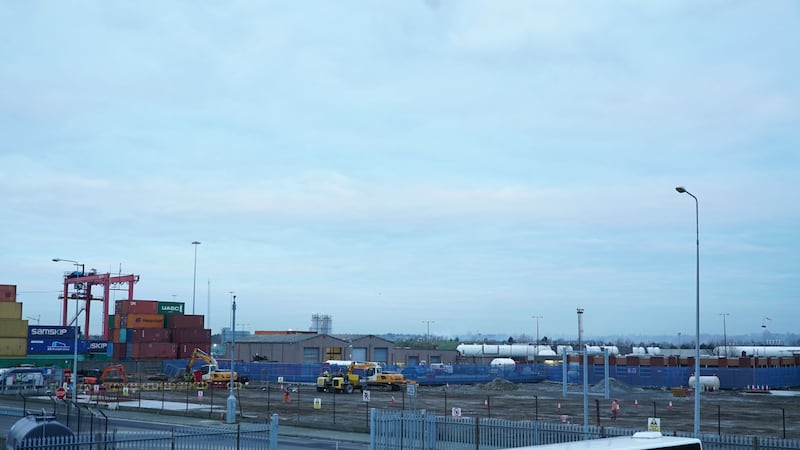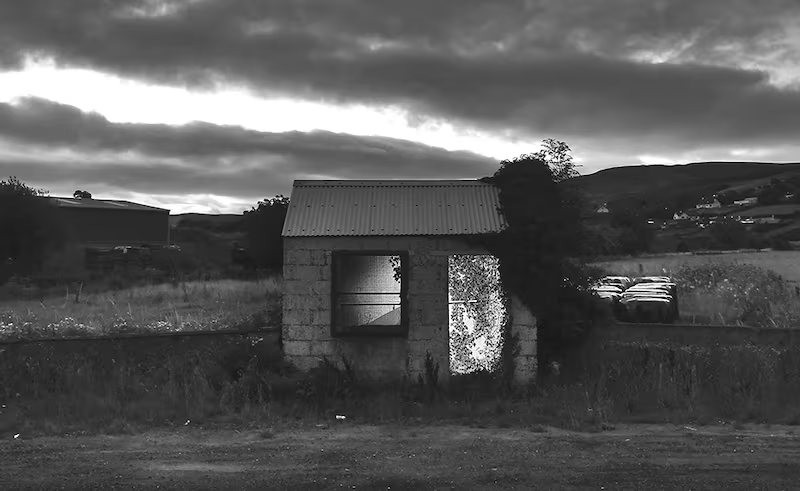"There are your sandwiches from Marks & Spencer's," says Dublin Port Company chief executive Eamonn O'Reilly, pointing to one of the supermarket chain's food lorries as it roars past.
The lorry is one of dozens to pour out of the bow doors of the Ulysses, the Irish Ferries vessel, shortly before 6am at Dublin Port. Forty-five minutes earlier, the ferry arrived from Holyhead. In less than two hours, at 7.57am, it will depart again for Holyhead and repeat the journey later that afternoon and evening.
The trucks – roll-on, roll-off or “ro-ro” traffic as they are known in the port – carry the branding of the country’s best-known retailers. They arrive long before most of their customers wake up.


"This is the economy on the move," says Michael Sheary, the port's financial controller, standing next to O'Reilly as they watch the noisy spectacle of a pre-daybreak port running at full throttle.
Both men wear hard hats and high-vis bibs. In the early morning darkness at the busiest port on the island, it is important to be seen at the busiest time of the day, particularly as the last containers are taken off the ferries. Drivers spin in revolving driving seats in lorry cabs, shuttling backwards and forwards at speed to haul unaccompanied trailers off the Ulysses.
The convoy spilling out of the ferry includes everything from refrigerated lorries or “reefers” to second-hand car transporters and horse trucks.
"That's one of the checks that will have to happen because of Brexit: live animals," says O'Reilly of one of four horse transporters he counts driving off the Ulysses.
This is Ireland's ground zero for Brexit, the front line on a new border for the European Union with the United Kingdom. Dublin Port will be the State's single busiest outpost for customs checks and border inspections should Britain depart the EU on schedule on March 29th.
‘Gate to the economy’
O’Reilly and his team manage a working area more than a third of the size of the Phoenix Park. He calls the narrow stretch of water at the mouth of the port between the North Bull Lighthouse on the northside of Dublin and Poolbeg Lighthouse the “gate to the economy”. It is only wide enough to accommodate one ship at a time. Almost 90 per cent of the “ro-ro” road freight coming on and off the island on ships passes through this 330m gap.
"This is the border – you've seen the border!" the port chief declares, standing on a dock as he brings The Irish Times on a tour of the 760-acre site as it ramps up preparations for Brexit in 69 days' time.
Just 20 minutes after the Ulysses doors opened, the ship has emptied its load over two ramps into the port. The ferry has the capacity to carry more than 4km of trucks in its lanes.
This is only part of the morning traffic at the port. In one hour, between 4.25am and 5.30am, four ferries carrying up to 13 lane-kilometres of lorries and other heavy goods vehicles arrive from Holyhead and Liverpool on vessels operated by P&O Ferries, Seatruck, Stena Line and Irish Ferries. All told, there were 48 ship "movements" on the day of our visit, a typical daily number for the port.
Half of the lorries driving off the 5.16am Ulysses left the port within minutes of driving off its ramps. They head via the Dublin Port Tunnel for the M50 ring-road around Dublin and beyond.
“They’ll all head out the tunnel before the rush hour. The reason the ferries come in at this time? These customers,” explains O’Reilly, pointing to the lorries, “that’s when they want to hit the road.”
Time-consuming inspections
There are no delays now because on freight from the UK there are no checks, customs, regulatory or otherwise. All this is due to change at 11pm on March 29th. Few are certain about what the changes will bring because of the political uncertainty in London and the UK parliament’s rejection of the EU-UK withdrawal agreement this week, but the port will be forced to manage, deal or no deal.
The port is spending €30 million in preparation: €10 million on primary inspection posts and €20 million on secondary posts for State agencies including Revenue Commissioners and Department of Agriculture officials carrying out a fivefold increase in checks on goods requiring customs clearance and, in addition, new food and animal health checks on goods and animals arriving from the UK.
O’Reilly shows us a large, fenced-off area, currently a construction site, next to the StenaLine terminal on the north side of the port where the primary inspections will take place. Here, by March 29th, lanes, booths, canopies and parking bays will be built. Lorry and van drivers will be checked and an official will tell them whether they can leave the port. They could also be pulled aside for further investigation or asked to move to a warehouse just beyond this site for additional, secondary inspections.
It is the secondary inspections that will require the most intensive and time-consuming work, where road freight containers and lorries may have to be unpacked to have their contents inspected.
“What we are building is designed to make sure that the checks that are necessary by State agencies can be done in Dublin as efficiently as possible,” he said.
“You cannot have queues of vehicles coming off ferries passing through a chokepoint without there being some delays. We think this will operate quite efficiently.”
Traffic delays
The 59-year-old port boss is remarkably calm given a major economic event with unknown consequences is arriving in just under 10 weeks’ time.
The company has carried out a detailed analysis that is guiding its preparations. Right now, O’Reilly says, the port handles 200,000 freight units from outside the EU coming in on containers. These are already checked by customs officials at the port’s three lift-on, lift-off or “lo-lo” terminals, the giant cranes that can be seen from outside the port.
Overnight, the UK’s departure from the EU will push that to one million units. Half of the increase will arrive on lorries, hence the likelihood of traffic delays inside the port after Brexit.
“It’s a great big increase but it is not a step into the unknown,” said O’Reilly. “Things will not move as quickly but they will continue to move.”
The port will have the infrastructure necessary in place to allow the full range of inspections to begin, he says.
Shipments of food and animals make speedy transit after Brexit essential. The port’s main concern is that ferry companies and their customers will not have the right customs documentation lodged in advance. That is not O’Reilly’s only concern.
“We would be concerned that the Irish authorities might attempt to do more than they have the capacity to do on day one,” he said.
On Tuesday, the port featured prominently in the Government's no-deal contingency plan briefing led by Tánaiste Simon Coveney. At the briefing, Minister for Transport Shane Ross shared Dublin Port's concerns about delayed shipments of food and other perishable and short shelf-life products and the expected disruption.
Contradictory statements from the two Ministers on checks elsewhere, on the Border with Northern Ireland, did not instill confidence that the Government is ready for a no-deal Brexit.
“The Irish State cannot be fully ready for the consequences of a hard Brexit on the 29th of March,” said O’Reilly, standing on a quayside five days before the Government briefing. “There is nobody fooling themselves that that can be the case. We have just got to make do with what we have.”
O’Reilly says the port’s job is easy by comparison. The Government has “done a magnificent job” preparing against the backdrop of London’s topsy-turvy political drama around Brexit, he adds.
“Ireland can’t control what is happening in Westminster. That is the great unknown,” he said. “We watch it like we watch a pantomime. It is entertaining, it is frightening but we ignore it.”
Unpredictable
From the outset, O'Reilly decided not to second-guess unpredictable British politics and took the Brexit "red lines" set by Theresa May in her Lancaster House speech in January 2017 as a guide – that the UK would be leaving the EU single market and customs union – and planned accordingly.
“If we spend a huge amount of money here and it turns out to be wasted, okay I will hold my hand up to say we got it wrong. But you show me the person that is guaranteed that Brexit won’t happen,” said O’Reilly, who sees the situation as a case of “damned if we do and damned if we don’t”.
The pragmatic O’Reilly is approaching Brexit in the same manner as the 2002 changeover to euro notes and coins, a project he worked on.
“There you had a date. You had certainty as to what needed to be done. At midnight, all of a sudden we were using euro. We are taking that view of Brexit: taking Britain at face value,” he said.
Shane Ross identified Dublin Port as one of the Brexit “pinch-points” where there could be delays, particularly on the UK landbridge, the speedier and favoured route for road hauliers carrying fresh “just-in-time” food and time-sensitive delivers to Europe. O’Reilly says the multitude of players in “immensely complex” supply chains have to do their jobs to mitigate against delays from Brexit.
“As long as everybody does their job within the supply chain, the goods will move. If anybody doesn’t do their job within their supply chain, there will be choke points, congestion,” he said.
He acknowledges there will be shifts and changes in patterns when it comes to transporting goods. He points out that two and a half times more trade goods move directly between Ireland and continental Europe than across the landbridge. Direct shipments will inevitably increase, he says, if Brexit starts to “shut off” the landbridge, something the Government is preparing for.
“That means more inventory costs in business. Time sensitive or perishable goods will struggle, if they can’t move quickly. Most of the business will move more slowly but they will still move,” he said.
The port boss pours cold water on suggestions that Brexit-related congestion will force ferry companies to look to other ports, saying that the market will determine where ships dock and business customers want their goods to arrive into the commercial and population centre of the State.
He pooh-poohs perennial calls for the port to be moved out of the city to make way for housing and other projects, saying that it would cost €3 billion and take 20 years. In the lifecycle of the port with a concrete plan to continue growing, O’Reilly sees Brexit as a two-year blip to be planned around as it aims to double the number of trade tonnes handled by Dublin Port to 77 million by 2040.
"Dublin Port works really well today. It will continue to work really well because it has to," said O'Reilly, watching lorry after lorry drive at speed off the Ulysses in the pre-dawn darkness.
“It doesn’t have a choice.”


















